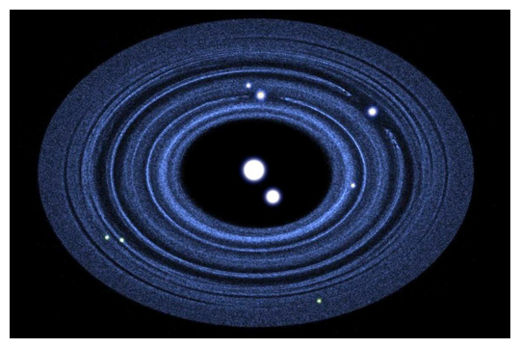
© S. Keyon, NASA
A recent simulation predicts that NASA's New Horizons probe could slam into a rocky killing field encircling
the "binary planet" Pluto-Charon, during its 2015 flyby.
That's according to a new theoretical dynamical simulation that predicts there could be as many as
10 moons circling the distant world - plus one or more ring systems.
The Hubble Space Telescope has discovered four small moons to date circling Pluto-Charon, but the other predicted moons many be so small and dim that they are undetectable even with Hubble's super-deep vision. The moons would lie beyond the orbit of the outermost known moon in the system, according to the simulation.
The discovered moons are Nix, Hydra, and
two others have been publicly voted to be named Cerberus and Vulcan, though official naming body, the International Astronomical Union (IAU), has yet to sanction the names.
This latest theoretical simulation by Scott Keyon of Center for Astrophysics at Harvard and Benjamin Bromley of the University of Utah could influence how NASA mission planners choose from several flyby options - ranging from "conservative" to "more risky but closer in to the icy dwarf."
The dilemma is that if New Horzons is shotgun-blasted by dust traveling at a relative speed of 35,000 mph, it will be destroyed before only a fraction of the flyby data as been downloaded to Earth.
What's especially intriguing about the new research, aside from providing estimates for navigation hazards to New Horizons, is that Pluto-Charon can be seen as a proxy for how planets form in stable orbits around close binary stars.
How did Pluto get so cluttered? The moons simply could have accreted from a circumplanetary disk, as is the likely case for the formation of Jupiter's major satellites.
But a popular scenario modeled by Robin Canup, of the University of Boulder, simulates an ancient collision between Pluto with another equally sized Kupier Belt object. One result is the formation of a fully intact moon, containing a significant percent of the mass of the central planet (Charon's mass is 1/7th Pluto's mass). Canup's simulations also show a spiral bar of debris stretching out and forming a ring around the collision.
In the more recent simulations the newly formed Charon either accretes or ejects debris on a time scale of less that three days. The leftover debris settles into a ring encircling Pluto and Charon, where particles collide and are ground down to smaller bits of dust.
In only 10 years the ring spreads into a broad disk and larger objects begin to coagulate. In no more than 100,000 years, bodies a few miles across migrate through the leftover smaller particles and gravitationally suck them up. This leaves behind a family of moonlets that are no more than a couple miles across. "The new simulations are the first to demonstrate migration-induced mergers within a particle disk," say the authors.
The researchers predict that during the July 2015 flyby, the New Horizons probe will detect a disk of small particles with rings and gaps as shown in the illustration at top. Once New Horizons has mapped the Pluto - Charon system completely, improved numerical simulations will enable astronomers to better understand the formation and evolution of the satellite system.
This latest research underscores the fact that scientists should not get hung up on
semantics. Back in 2006 the IAU had a golden opportunity to redefine Pluto and Charon as our first example of a binary planet, where two bodies pivot around each other like a pair of ice skaters. Instead, the attending astronomers - representing a fraction of the worldwide astronomical community - voted to go pedantic and dictate that Pluto is an un-planet.
Whatever you call Pluto, breakthrough discoveries mixed with melodrama lies ahead in the long-awaited New Horizons encounter.
Reader Comments
to our Newsletter